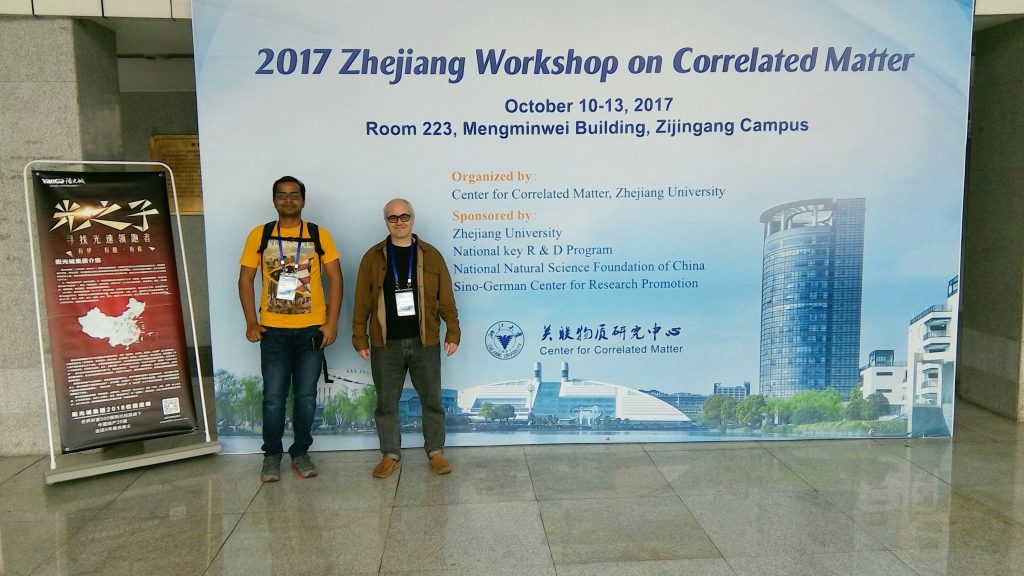Greetings from China! Yesterday I had the plesure to give an invited talk at the excellent 2017 Zhejiang Workshop on Correlated Matter organised by Huiqiu Yuan, Frank Steglich and their colleagues at the Centre for Correlated Matter at Zhejiang University. I copy the abstract of my talk below. The photo shows the two Kent delegates (Sudeep Ghosh and myself).
Theory of fully-gapped triplet pairing with broken time-reversal symmetry in LaNiGa2
Phil Whittlesea (1), Sudeep K. Ghosh (1), Gabor Csire (2), James F. Annett (2), Jorge Quintanilla (1)
(1) University of Kent, Canterbury, U.K.; (2) University of Bristol, Bristol, U.K.
Zero-field muon spin relaxation experiments suggest that the superconducting states of non-centrosymmetric LaNiC2 and its centrosymmetric relative, LaNiGa2, break time-reversal symmetry [1,2]. Standard symmetry analyses imply non-unitary triplet pairing [1,2,3], leading to the prediction [2] of a sub-dominant order parameter in the form of a bulk magnetisation. The latter is consistent with recent bulk SQUID magnetometer measurements of LaNiC2 [4]. On the other hand thermodynamicand transport measurements on LaNiC2 [5] and LaNiGa2 [6] imply a fully-gapped state, with two distinct values of the gap in both cases. It was proposed [6] for LaNiGa2 that this could be reconciled with earlier evidence for triplet pairing through an equal-spin, inter-orbital pairing model. Here we present a variational self-consistent mean-field theory that embodies such model. The phase diagram of the model has several unusual features, including a critical end-point where the superconducting transition turns first order, a region of gapless superconductivity, and possible re-entrant behaviour. We will discuss the conditions for such exotic physics to be realised in relation to key features of the electronic structure of LaNiGa2.
[1] AD Hillier, J Quintanilla, and R Cywinski, PRL 102 , 117007 (2009).
[2] AD Hillier, J Quintanilla, B Mazidian, JF Annett, and R Cywinski, PRL 109, 097001 (2012).
[3] J Quintanilla, AD Hillier, JF Annett, and R Cywinski, PRB 82, 174511 (2010).
[4] A Sumiyama, D Kawakatsu, J Gouchi, A Yamaguchi, G Motoyama, Y Hirose, R Settai, and Y Ōnuki, JPSJ 84, 013702 (2015).
[5] J Chen, L Jiao, JL Zhang, Y Chen, L Yang, M Nicklas, F Steglich, and HQ Yuan, NJP 15, 053005 (2013).
[6] ZF Weng, JL Zhang, M Smidman, T Shang, J Quintanilla, JF Annett, M Nicklas, GM Pang, L Jiao, WB Jiang, Y Chen, F Steglich, and HQ Yuan, PRL 17, 027001 (2016).

